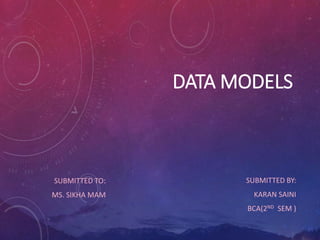Report
Share

Recommended
More Related Content
What's hot
What's hot (20)
Week 3 Classification of Database Management Systems & Data Modeling

Week 3 Classification of Database Management Systems & Data Modeling
Week 1 Before the Advent of Database Systems & Fundamental Concepts

Week 1 Before the Advent of Database Systems & Fundamental Concepts
Similar to Data models
Similar to Data models (20)
chapter 2-DATABASE SYSTEM CONCEPTS AND architecture [Autosaved].pdf![chapter 2-DATABASE SYSTEM CONCEPTS AND architecture [Autosaved].pdf](data:image/gif;base64,R0lGODlhAQABAIAAAAAAAP///yH5BAEAAAAALAAAAAABAAEAAAIBRAA7)
![chapter 2-DATABASE SYSTEM CONCEPTS AND architecture [Autosaved].pdf](data:image/gif;base64,R0lGODlhAQABAIAAAAAAAP///yH5BAEAAAAALAAAAAABAAEAAAIBRAA7)
chapter 2-DATABASE SYSTEM CONCEPTS AND architecture [Autosaved].pdf
Student POST Database processing models showcase the logical s.docx

Student POST Database processing models showcase the logical s.docx
M.sc. engg (ict) admission guide database management system 4

M.sc. engg (ict) admission guide database management system 4
Schema Integration, View Integration and Database Integration, ER Model & Dia...

Schema Integration, View Integration and Database Integration, ER Model & Dia...
1.1 Data Modelling - Part I (Understand Data Model).pdf

1.1 Data Modelling - Part I (Understand Data Model).pdf
Recently uploaded
https://app.box.com/s/x7vf0j7xaxl2hlczxm3ny497y4yto33i80 ĐỀ THI THỬ TUYỂN SINH TIẾNG ANH VÀO 10 SỞ GD – ĐT THÀNH PHỐ HỒ CHÍ MINH NĂ...

80 ĐỀ THI THỬ TUYỂN SINH TIẾNG ANH VÀO 10 SỞ GD – ĐT THÀNH PHỐ HỒ CHÍ MINH NĂ...Nguyen Thanh Tu Collection
Recently uploaded (20)
80 ĐỀ THI THỬ TUYỂN SINH TIẾNG ANH VÀO 10 SỞ GD – ĐT THÀNH PHỐ HỒ CHÍ MINH NĂ...

80 ĐỀ THI THỬ TUYỂN SINH TIẾNG ANH VÀO 10 SỞ GD – ĐT THÀNH PHỐ HỒ CHÍ MINH NĂ...
dusjagr & nano talk on open tools for agriculture research and learning

dusjagr & nano talk on open tools for agriculture research and learning
Simple, Complex, and Compound Sentences Exercises.pdf

Simple, Complex, and Compound Sentences Exercises.pdf
Introduction to TechSoup’s Digital Marketing Services and Use Cases

Introduction to TechSoup’s Digital Marketing Services and Use Cases
Exploring_the_Narrative_Style_of_Amitav_Ghoshs_Gun_Island.pptx

Exploring_the_Narrative_Style_of_Amitav_Ghoshs_Gun_Island.pptx
Beyond_Borders_Understanding_Anime_and_Manga_Fandom_A_Comprehensive_Audience_...

Beyond_Borders_Understanding_Anime_and_Manga_Fandom_A_Comprehensive_Audience_...
Data models
- 1. DATA MODELS SUBMITTED TO: MS. SIKHA MAM SUBMITTED BY: KARAN SAINI BCA(2ND SEM )
- 2. DATA MODEL SHOWS THE LOGICAL STRUCTURE OF A DATABASE INCLUDING RELATIONSHIP AND CONSTRAINTS THAT DETERMINE HOW DATA CAN STORED AND ACCESSED. What is data model?
- 3. Data Model Basic Building Blocks Entity:-Anything about which data are to be collected and stored Attribute:- A characteristic of an entity. Relationship:-An association among entities. 1. One to one(1:1) relationship 2. One to many(1:M) relationship 3. Many to one(M:1) relationship 4. Many to many(M:M) relationship
- 4. Object Based Data Models Physical Data Models Record Based Logical Data Models TYPES OF DATA MODELS
- 5. It uses concepts such as Entities, attributes and relationship. Types of object based models: Entity Relationship Object Oriented Semantics Functional
- 6. It describe how data is stored in the computer, representing information such as record structures, record ordering and access paths. Less no. of models are there.
- 7. IT IS USED TO SPECIFY THE OVERALL LOGICAL STRUCTURE OF THE DATABASE AND TO PROVIDE A HIGHER LEVEL DESCRIPTION OF THE IMPLEMENTATION. STRUCTURED DATABASE IN FIXED FORMATS.
- 9. Hierarchical model is one of the oldest database in which data is organized into tree like structure. This model uses a one to many (1:M) relationship for data elements. Hierarchical database were popular in early database design, in the era of mainframe computers. HIERARCHICAL DIAGRAM
- 10. Simplicity Data security Data Integrity Efficiency Complexity Not Flexible Dependence Extra Space
- 11. NETWORK MODEL In 1965 C.W.BACHMAN developed the first network data model to present complex data relationships more effectively than hierarchical model. In network model the multiple parent-child relationships are used.
- 12. Conceptual Simplicity Capability Data Integrity Ease to access data Data Independence Complexity Confusion Lack of structural Independence
- 13. RELATIONAL MODEL The most popular data model in DBMS is the relational data model . In this model ,data is organized in the terms of rows(tuple) and columns(attributes) in a table known as RELATION. The principal of relational model were first outlined by Dr.E.F.Codd.
- 14. Conceptual Simplicity Structural Independence Design Implementation Security Hardware Overheads Expensive Storage
- 15. THANK YOU!